Achieving Cost Minimization and Fairness in Multi-Supplier Smart Grid Environment
Abstract
:1. Introduction
1.1. Related Work
1.2. Motivation
1.3. Contributions
- We first formulate a consumer-to-utility assignment problem such that multiple users can be served by each utility while a particular consumer can be assigned to one and only one supplier in a given time.
- A dual decomposition-based solution is presented such that the overall cost is minimized subject to the limited available capacity of each utility. In the proposed solution, a user can choose different utilities in different time slots, thus, each utility has an independent set of users in each time.
- Later, a low complexity sub-optimal solution is proposed to minimize the sum system cost. In this algorithm, utilities are assigned to different users in sequential manner such that supplier with minimum price is selected first and users are assigned until the maximum capacity is reached.
- Then, a fair cost minimization problem is formulated as min–max optimization under the same constraints. The complex min–max problem is first re-formulated to standard minimization problem and then duality theory is exploited to obtain the an efficient solution where dual problem is solved though sub-gradient method.
- Similar to the sum cost minimization, a low complexity algorithm for fair cost minimization is also designed.
- Finally, simulation results are presented to validate the performance of the proposed schemes.
1.4. System Model
1.5. Organization of manuscript
2. Total Cost Minimization
2.1. Proposed Scheme
2.2. Suboptimal Scheme for Total Cost Minimization
| Algorithm 1 Suboptimal scheme for sum cost minimization. |
|
3. Fair Cost Minimization
3.1. Proposed Solution
3.2. Suboptimal Scheme for Fair Cost Minimization
| Algorithm 2 Suboptimal scheme for fair cost minimization. |
|
4. Simulation Results
- OptSol: This refers to the proposed solutions in Section 2.1 and Section 3.1.
- SubOptSol: Low complexity sub-optimal schemes proposed in Section 2.2 and Section 3.2.
- NonOptSol: In this solution, users are selected randomly and are assigned to a randomly selected utility for the entire time horizon. This allocation stay continued until utility is unable to serve more consumers. Then another utility is selected and this scenario is continued until all the consumers are scheduled for all time slots.
4.1. Simulation Results For Total Cost Minimization
4.2. Simulation Results For Fair Cost Minimization
5. Conclusions
Author Contributions
Funding
Acknowledgments
Conflicts of Interest
References
- Bahrami, S.; Wong, V.W.S. An autonomous demand response program in smart grid with foresighted users. In Proceedings of the 2015 IEEE International Conference on Smart Grid Commun. (SmartGridComm), Miami, FL, USA, 2015; pp. 205–210. [Google Scholar]
- Amini, M.H.; Nabi, B.; Haghifam, M.R. Load management using multi-agent systems in smart distribution network. In Proceedings of the IEEE Power & Energy Society General Meeting, Vancouver, ON, Canada, 21–25 July 2013; pp. 1–5. [Google Scholar]
- Farhangi, H. The path of the smart grid. IEEE Power Energy Mag. 2010, 8, 18–28. [Google Scholar] [CrossRef]
- Gharavi, H.; Ghafurian, R. Smart grid: The electric energy system of the future. IEEE 2011, 99, 917–921. [Google Scholar] [CrossRef]
- Xi, F.; Satyajayant, M.; Guoliang, X.; Dejun, Y. Smart grid—The new and improved power grid: A survey. IEEE Commun. Surv. Tutor. 2011, 14, 1–37. [Google Scholar]
- Boroojeni, K.G.; Amini, M.H.; Bahrami, S.; Iyengar, S.S.; Sarwat, A.I.; Karabasoglu, O. A novel multi-time-scale modeling for electric power demand forecasting: From short-term to medium-term horizon. Electr. Power Syst. Res. 2017, 142, 58–73. [Google Scholar] [CrossRef]
- Mohammadi, A.; Mehrtash, M.; Kargarian, A. Diagonal quadratic approximation for decentralized collaborative TSO+DSO optimal power flow. IEEE Trans. Smart Grid 2018. [Google Scholar] [CrossRef]
- Bahrami, S.; Toulabi, M.; Ranjbar, S.; Aghtaie, M.M.; Ranjbar, A.M. A decentralized energy management framework for energy hubs in dynamic pricing markets. IEEE Trans. Smart Grid 2017. [Google Scholar] [CrossRef]
- Palensky, P.; Dietrich, D. Demand side management: Demand response, intelligent energy systems, and smart loads. IEEE Trans. Ind. Inform. 2011, 7, 381–388. [Google Scholar] [CrossRef]
- Ramanathan, B.; Vittal, V. A framework for evaluation of advanced direct load control with minimum disruption. IEEE Trans. Power Syst. 2008, 23, 1681–1688. [Google Scholar] [CrossRef]
- Basit, A.; Sidhu, G.A.S.; Mahmood, A.; Gao, F. Efficient and autonomous energy management techniques for the future smart homes. IEEE Trans. Smart Grid 2017, 8, 917–926. [Google Scholar] [CrossRef]
- Gellings, C.W.; Chamberlin, J.H. Demand Side Management: Concepts and Methods, 2nd ed.; PennWell Books: Tulsa, OK, USA, 1993. [Google Scholar]
- Weers, D.D.; Shamsedin, M.A. Testing a new direct load control power line communication system. IEEE Trans. Power Del. 1987, 2, 657–660. [Google Scholar] [CrossRef]
- Chu, C.M.; Jong, T.L.; Huang, Y.W. A direct load control of air-conditioning loads with thermal comfort control. In Proceeding of the IEEE Power Engineering Society General Meeting, San Francisco, CA, USA, 16 June 2005; pp. 664–669. [Google Scholar]
- Gomes, A.; Antunes, C.H.; Martins, A.G. A multiple objective approach to direct load control using an interactive evolutionary algorithm. IEEE Trans. Power Syst. 2007, 22, 1004–1011. [Google Scholar] [CrossRef]
- Jindal, A.; Kumar, N.; Rodrigues, J.J. A heuristic-based smart HVAC energy management scheme for university buildings. IEEE Trans. Ind. Inform. 2018. [Google Scholar] [CrossRef]
- Tiptipakorn, S.; Wei-Jen, L. A residential consumer-centered load control strategy in real-time electricity pricing environment. In Proceedings of the 39th North American Power Symposium, Las Cruces, NM, USA, 30 September–2 October 2007; pp. 505–510. [Google Scholar]
- Zhao, Z.; Lee, W.C.; Shin, Y.; Song, K.B. An optimal power scheduling method for demand response in home energy management system. IEEE Trans. Smart Grid 2013, 4, 1391–1400. [Google Scholar] [CrossRef]
- Ruiz, N.; Cobelo, I.; Oyarzabal, J. A direct load control model for virtual power plant management. IEEE Trans. Power Systems 2009, 24, 959–966. [Google Scholar] [CrossRef]
- Tarasak, P. Optimal real-time pricing under load uncertainty based on utility maximization for smart grid. In Proceedings of the IEEE International Conference on Smart Grid Communications (SmartGridComm), Brussels, Belgium, 17–20 October 2011; pp. 321–326. [Google Scholar]
- Chen, H.; Li, Y.; Louie, R.H.; Vucetic, B. Autonomous demand side management based on energy consumption scheduling and instantaneous load billing: An aggregative game approach. IEEE Trans. Smart Grid 2014, 5, 1744–1754. [Google Scholar] [CrossRef]
- Mohsenian-Rad, A.H.; Leon-Garcia, A. Optimal residential load control with price prediction in real-time electricity pricing environments. IEEE Trans. Smart Grid 2010, 1, 120–133. [Google Scholar] [CrossRef]
- Shinwari, M.; Youssef, A.; Hamouda, W. A water-filling based scheduling algorithm for the smart grid. IEEE Trans. Smart Grid 2012, 3, 710–719. [Google Scholar] [CrossRef]
- Mohsenian-Rad, A.H.; Wong, V.W.; Jatskevich, J.; Schober, R.; Leon-Garcia, A. Autonomous demand-side management based on game-theoretic energy consumption scheduling for the future smart grid. IEEE Trans. Smart Grid 2010, 1, 320–331. [Google Scholar] [CrossRef]
- Ma, K.; Hu, G.; Spanos, C.J. Energy consumption scheduling in smart grid: A non-cooperative game approach. In Proceedings of the 9th Asian Control Conference (ASCC), Istanbul, Turkey, 23–26 June 2013; pp. 1–6. [Google Scholar]
- Imamura, A.; Yamamoto, S.; Tazoe, T.; Onda, H.; Takeshita, H.; Okamoto, S.; Yamanaka, N. Distributed demand scheduling method to reduce energy cost in smart grid. In Proceedings of the IEEE Region 10 Humanitarian Technology Conference (R10-HTC), Sendai, Japan, 26–29 August 2013; pp. 148–153. [Google Scholar]
- Guo, Y.; Pan, M.; Fang, Y.; Khargonekar, P.P. Coordinated energy scheduling for residential households in the smart grid. In Proceedings of the IEEE Third International Conference on Smart Grid Communications (SmartGridComm), Tainan, Taiwan, 5–8 November 2012; pp. 121–126. [Google Scholar]
- Xiao, J.; Chung, J.Y.; Li, J.; Boutaba, R.; Hong, J.W.K. Near optimal demandside energy management under real-time demand-response pricing. In Proceedings of the International Conference on Network and Service Management (CNSM), Niagara Falls, ON, USA, 25–29 October 2010; pp. 527–532. [Google Scholar]
- Bae, H.; Yoon, J.; Lee, Y.; Lee, J.; Kim, T.; Yu, J.; Cho, S. User-friendly demand side management for smart grid networks. In Proceedings of the International Conference on Information Networking (ICOIN), Phuket, Thiland, 10–12 February 2014; pp. 481–485. [Google Scholar]
- Assaf, T.; Osman, A.H.; Hassan, M. Fair autonomous energy consumption scheduling based on game-theoretic approach for the future smart grid. In Proceedings of the 18th International Conference on Computer Modelling and Simulation (UKSim), Cambridge, UK, 6–8 April 2016; pp. 235–239. [Google Scholar]
- Ali, Z.; Sidhu, G.A.S.; Waqas, M.; Gao, F.; Jin, S. Achieving energy fairness in multiuser uplink CR transmission. In Proceedings of the IEEE Wireless Communication and Networking Conference, Doha, Qatar, 3–6 April 2016; pp. 1–6. [Google Scholar]
- Lin, J.; Yu, W.; Yang, X. Towards multistep electricity prices in smart grid electricity markets. IEEE Trans. Parallel Distrib. Syst. 2016, 27, 286–302. [Google Scholar]
- Vuppala, S.K.; Padmanabh, K.; Bose, S.K.; Paul, S. Incorporating fairness within demand response programs in smart grid. In Proceedings of the Innovative Smart Grid Technologies (ISGT), Hilton Anaheim, CA, USA, 17–19 January 2011; pp. 1–9. [Google Scholar]
- Baharlouei, Z.; Hashemi, M.; Narimani, H.; Mohsenian-Rad, H. Achieving optimality and fairness in autonomous demand response: Benchmarks and billing mechanisms. IEEE Trans. Smart Grid 2013, 4, 968–975. [Google Scholar] [CrossRef]
- Pal, S.; Thakur, S.; Kumar, R.; Panigrahic, B.K. A strategical game theoretic based demand response model for residential consumers in a fair environment. Int. J. Electr. Power Energy Syst. 2018, 97, 201–210. [Google Scholar] [CrossRef]
- Loe, R.R. Multi-utility metering for residential customers in a competitive utility environment. In Proceedings of the Ninth International Conference on Metering and Tariffs for Energy Supply, Birmingham, UK, 25–28 May 1992; pp. 37–42. [Google Scholar]
- Jalali, M.M.; Kazemi, A. Demand side management in a smart grid with multiple electricity suppliers. Energy 2015, 81, 766–776. [Google Scholar] [CrossRef]
- Mediwaththe, C.; Stephens, E.; Smith, D.; Mahanti, A. Competitive energy trading framework for demand-side management in neighborhood area networks. IEEE Trans. Smart Grid 2017. [Google Scholar] [CrossRef]
- Jalali, M.M.; Kazemi, A. Evaluation of demand-side management over pricing competition of multiple suppliers having heterogeneous energy sources. Energies 2017, 10, 1342–1358. [Google Scholar]
- Yu, M.; Hong, S.H. Incentive-based demand response considering hierarchical electricity market: A Stackelberg game approach. Appl. Energy 2017, 203, 267–279. [Google Scholar] [CrossRef]
- Schrijver, A. Theory of Linear and Integer Programming; John Wiley Sons: New York, NY, USA, 1998. [Google Scholar]
- Boyd, S.; Xiao, L.; Mutapcic, A. Subgradient Methods; notes for EE392e; Standford University: Stanford, CA, USA, 2003. [Google Scholar]

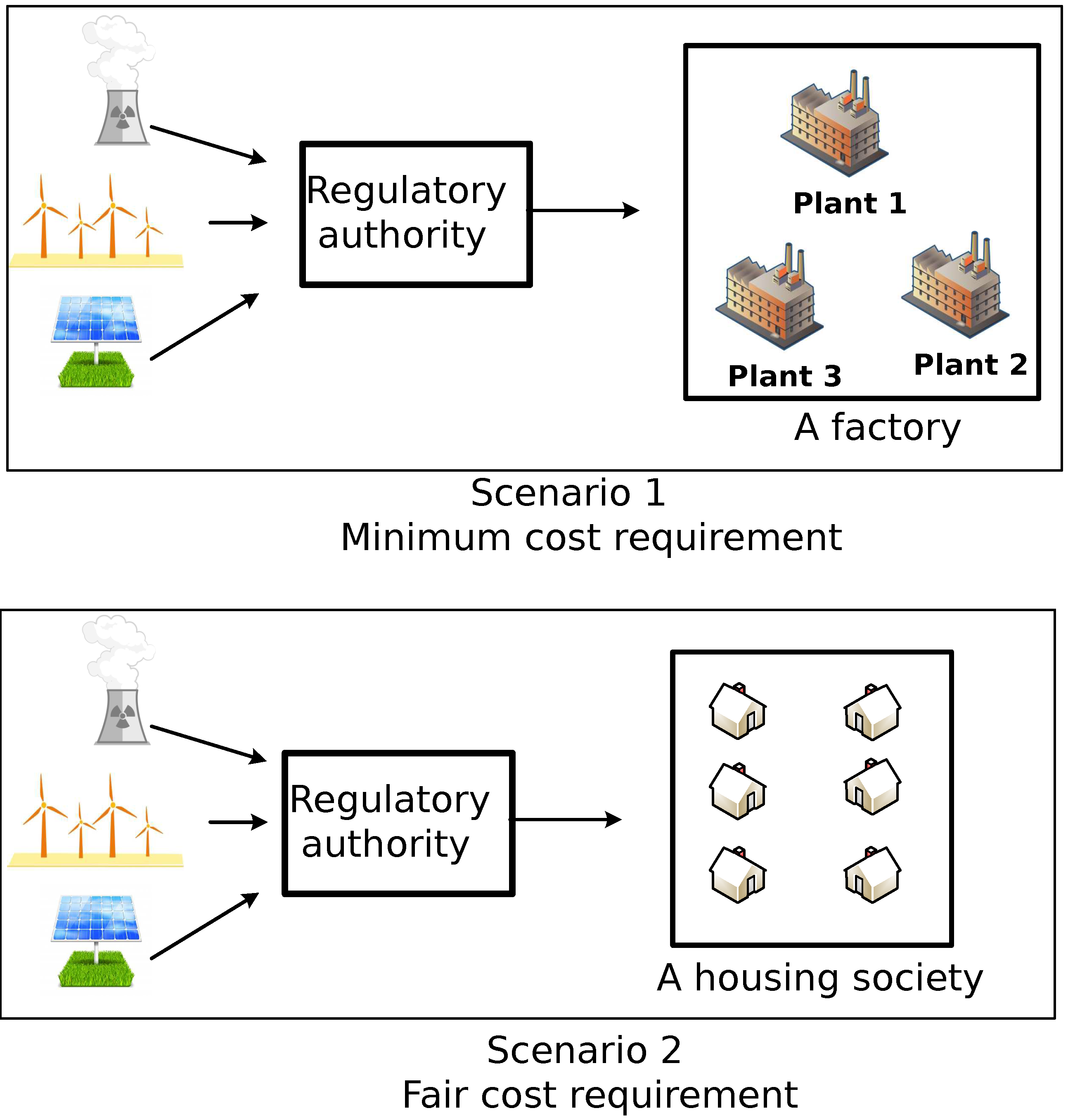
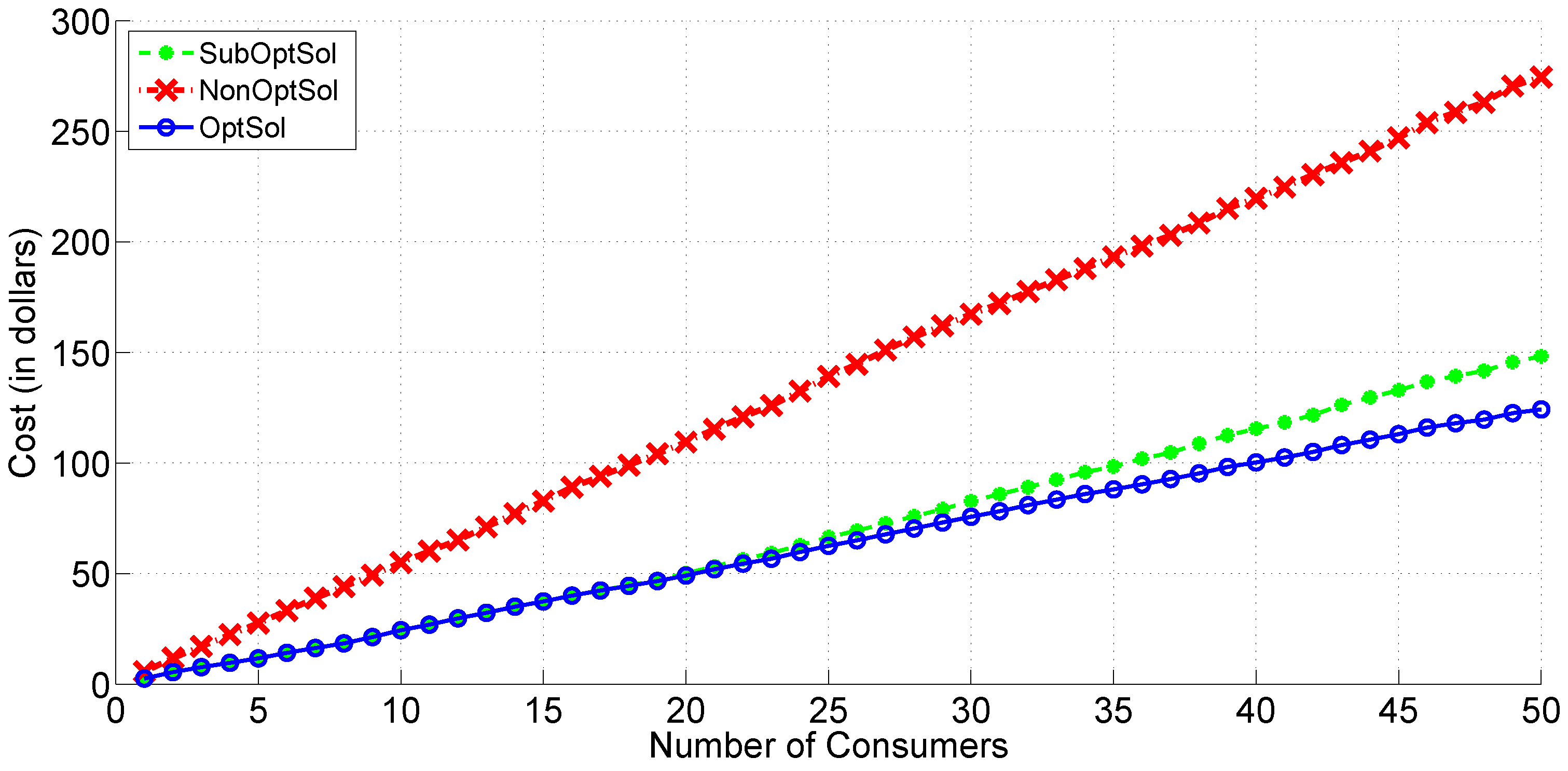
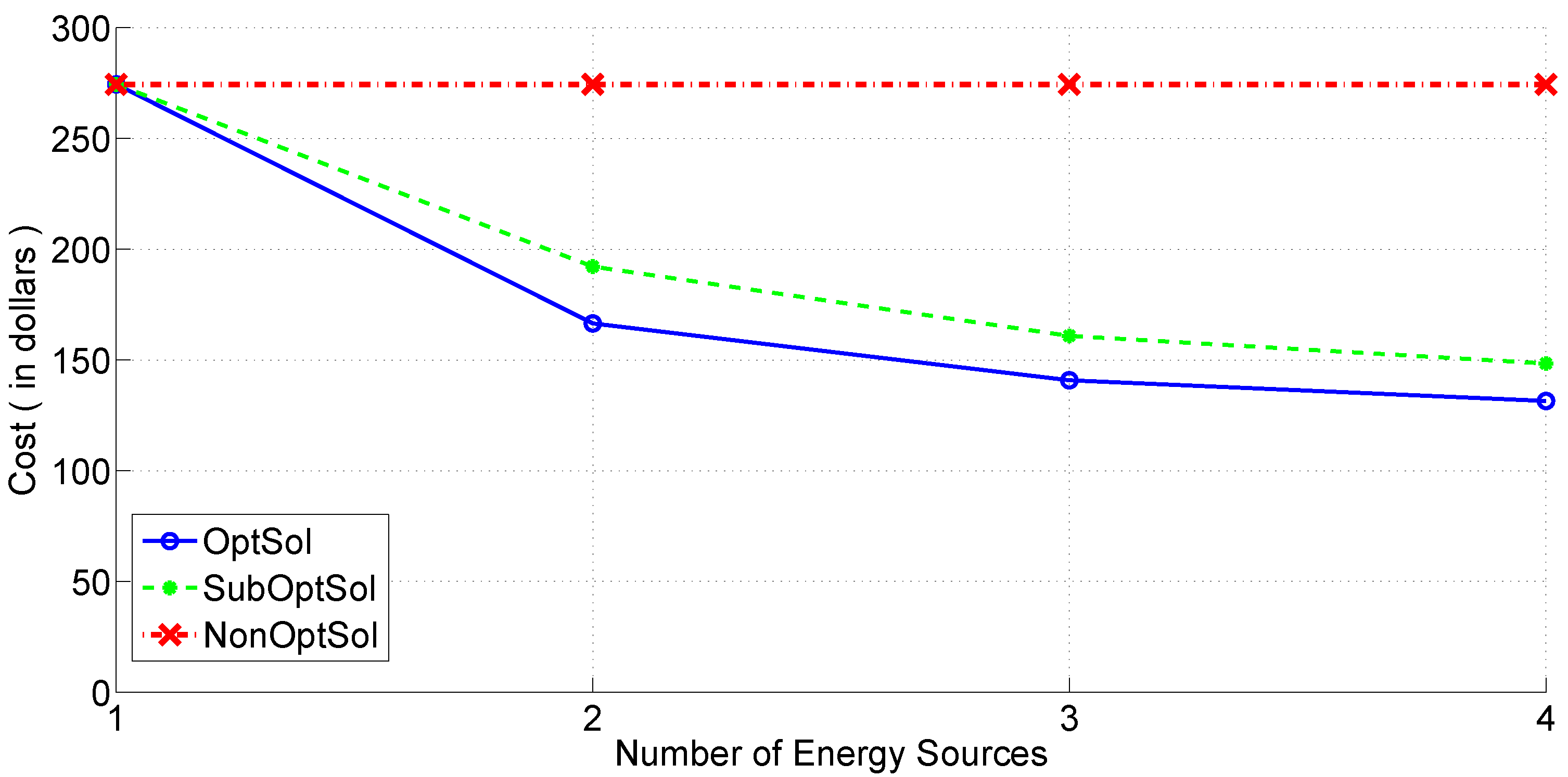
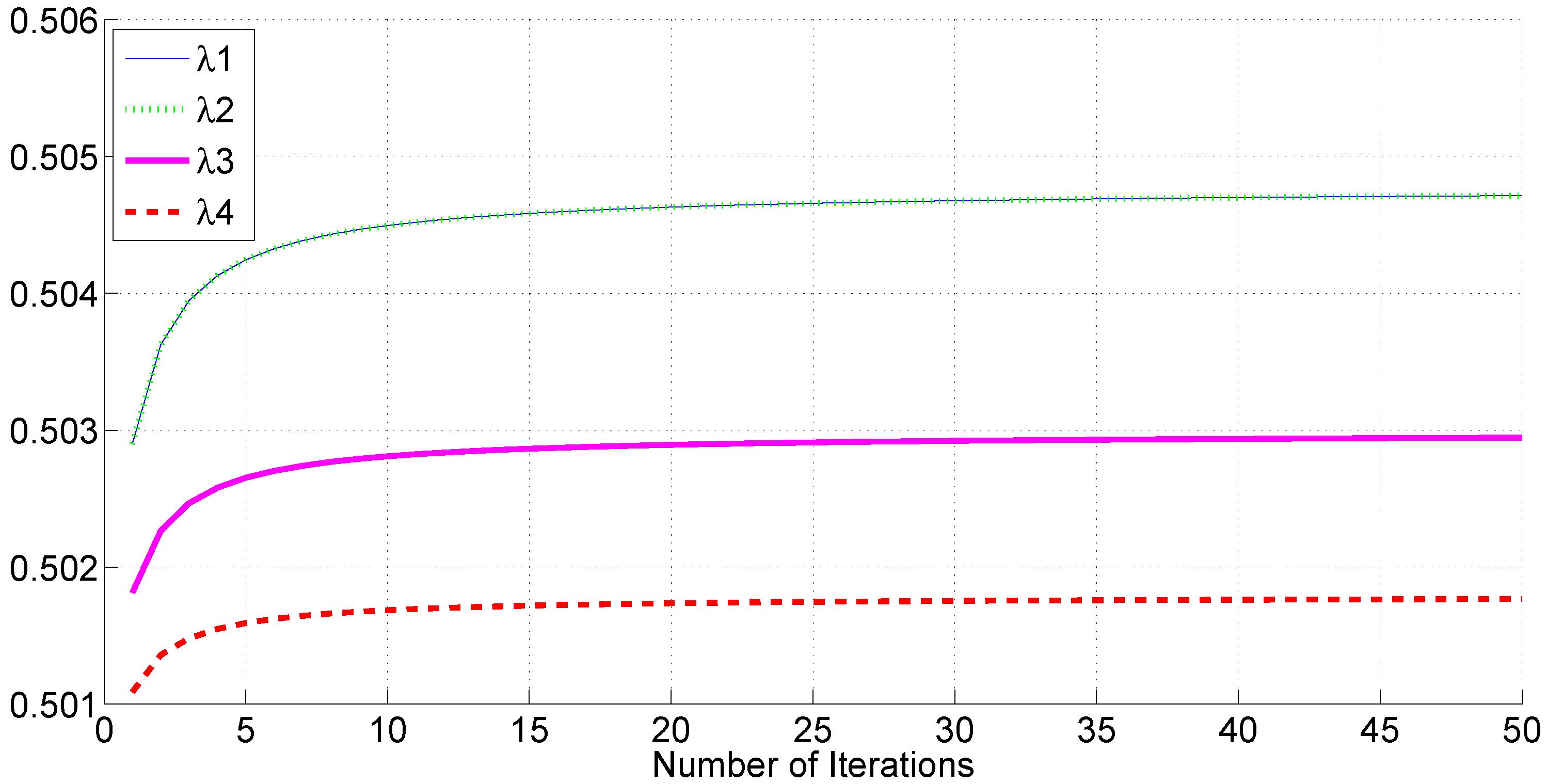


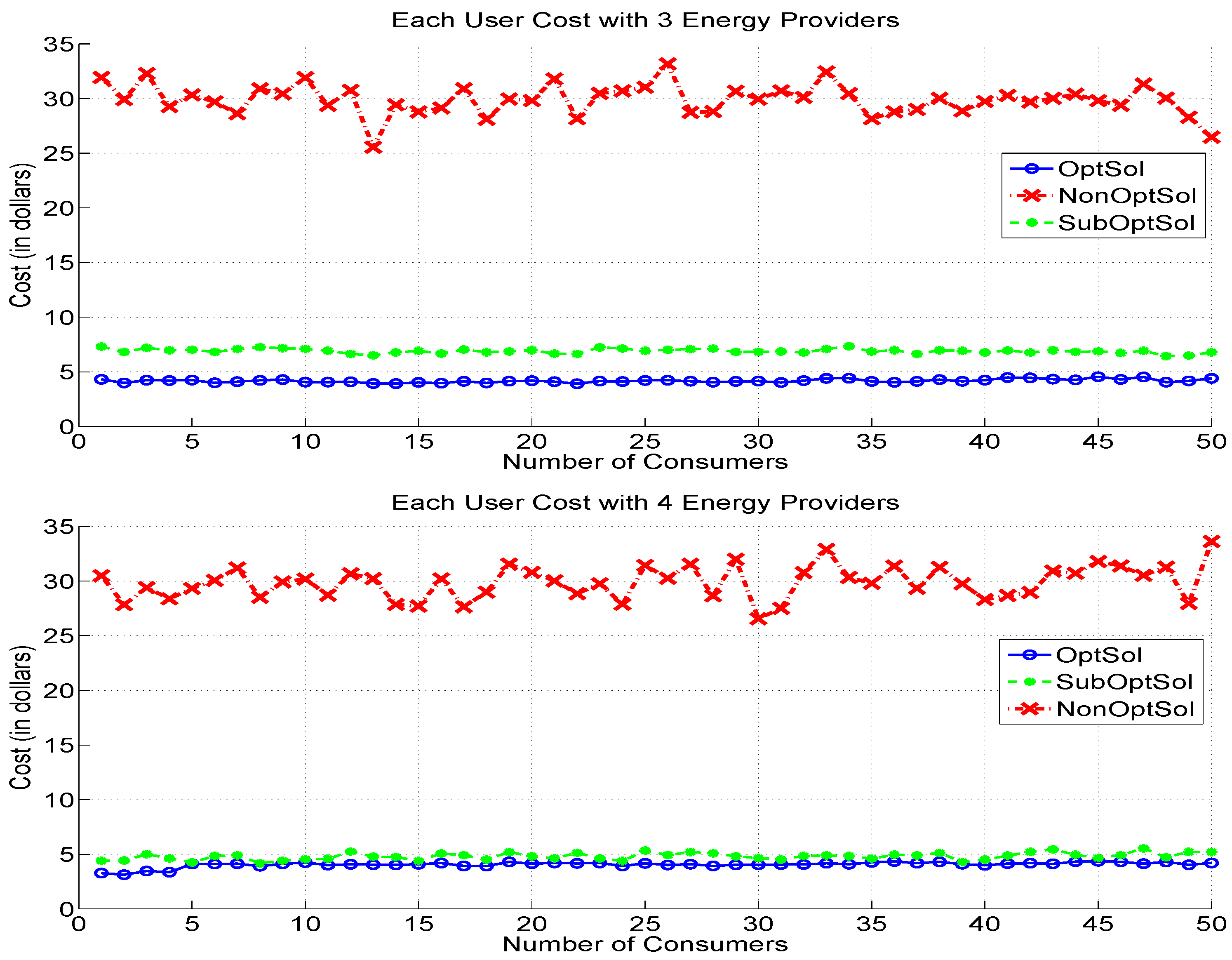
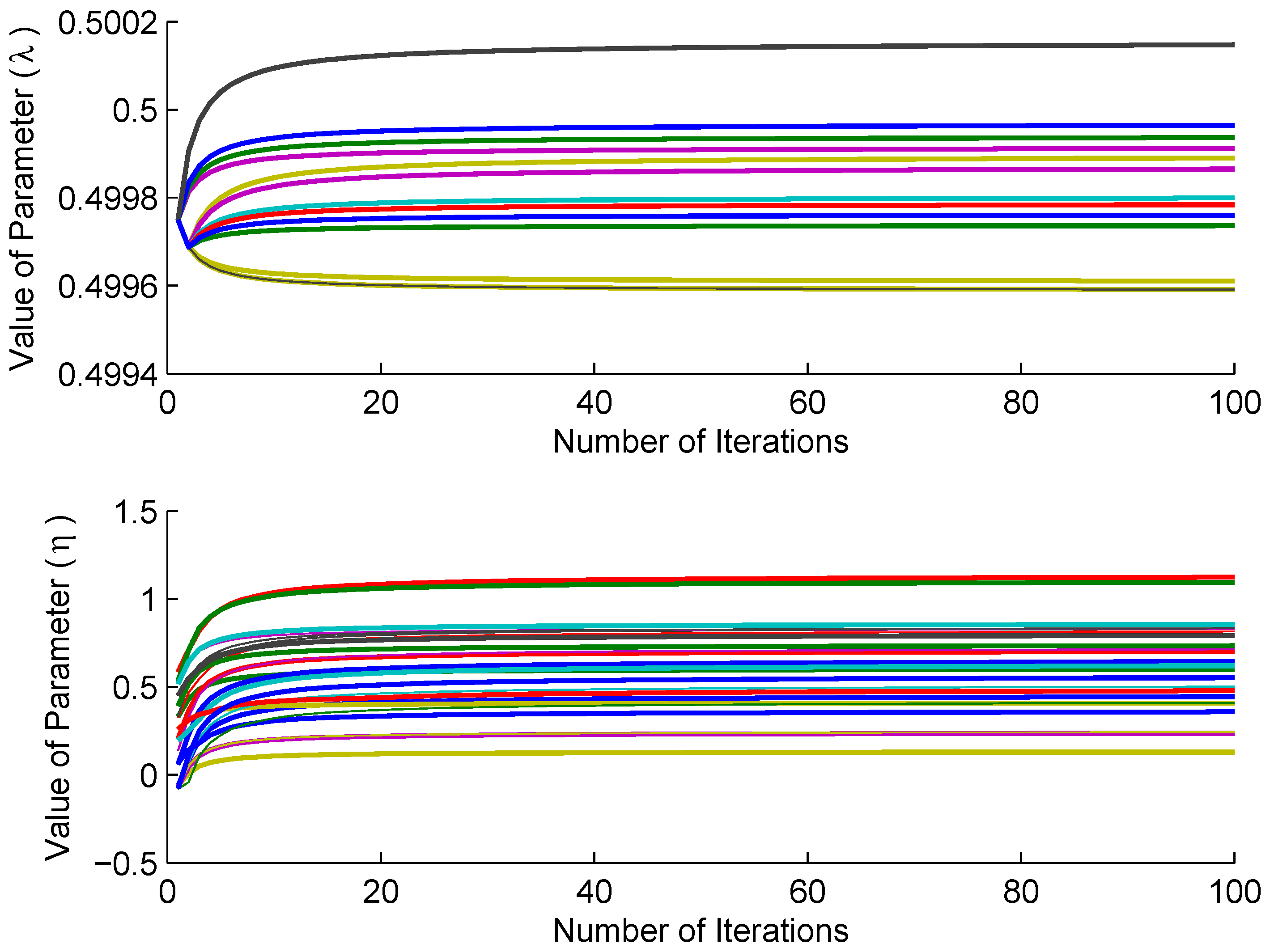
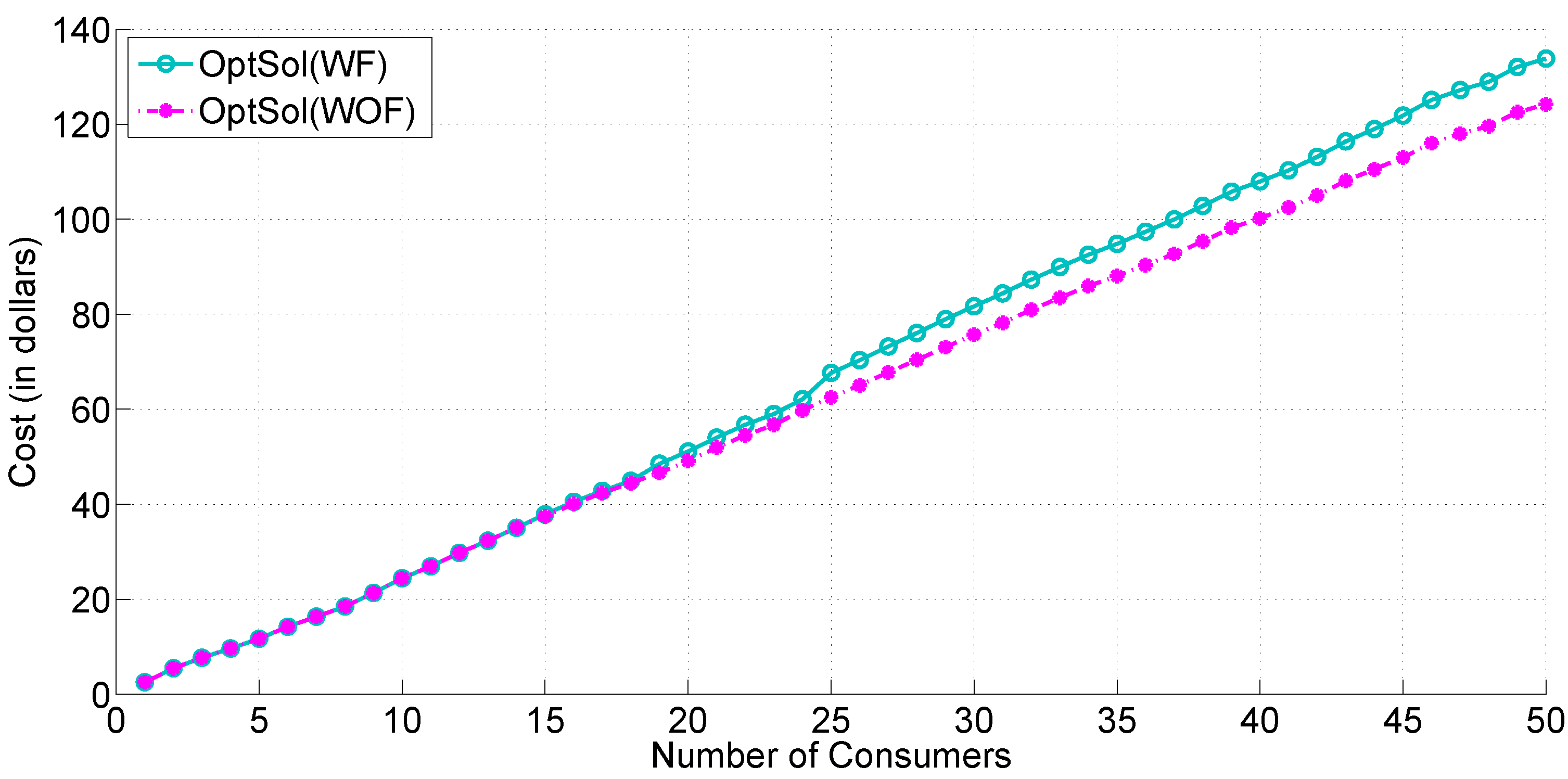
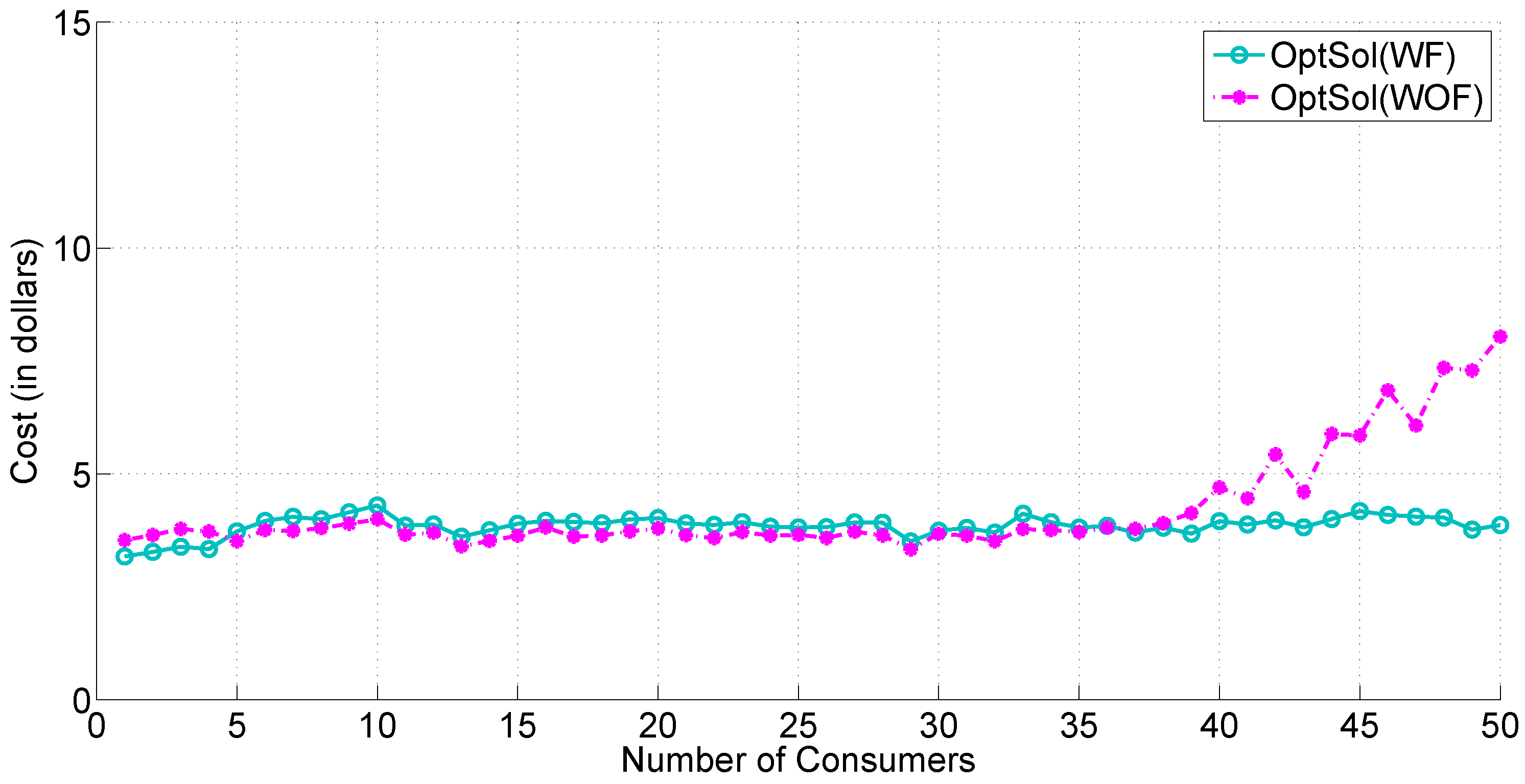
| Electricity price of ith energy provider in jth hour. | |
| Binary variable associated to the allocation of kth user to ith utility in jth hour. | |
| Energy consumption of kth user in jth hour. | |
| Generation capacity of ith energy provider. | |
| t | Auxiliary variable associated to the fairness constraint. |
| Dual variables. | |
| M | Number of consumers in the system. |
| N | Total energy providers in the system. |
| H | Total number of time slots. |
© 2018 by the authors. Licensee MDPI, Basel, Switzerland. This article is an open access article distributed under the terms and conditions of the Creative Commons Attribution (CC BY) license (http://creativecommons.org/licenses/by/4.0/).
Share and Cite
Malik, A.; Ali, Z.; Awan, A.B.; Abo-Khalil, A.G.; Sidhu, G.A.S. Achieving Cost Minimization and Fairness in Multi-Supplier Smart Grid Environment. Energies 2018, 11, 1367. https://doi.org/10.3390/en11061367
Malik A, Ali Z, Awan AB, Abo-Khalil AG, Sidhu GAS. Achieving Cost Minimization and Fairness in Multi-Supplier Smart Grid Environment. Energies. 2018; 11(6):1367. https://doi.org/10.3390/en11061367
Chicago/Turabian StyleMalik, Amna, Zain Ali, Ahmed Bilal Awan, Ahmed G. Abo-Khalil, and Guftaar Ahmad Sardar Sidhu. 2018. "Achieving Cost Minimization and Fairness in Multi-Supplier Smart Grid Environment" Energies 11, no. 6: 1367. https://doi.org/10.3390/en11061367
APA StyleMalik, A., Ali, Z., Awan, A. B., Abo-Khalil, A. G., & Sidhu, G. A. S. (2018). Achieving Cost Minimization and Fairness in Multi-Supplier Smart Grid Environment. Energies, 11(6), 1367. https://doi.org/10.3390/en11061367







